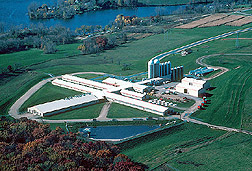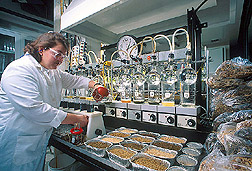Foraging Ahead |
|
|
|
The U.S. Dairy Forage Research Center, in Madison, Wisconsin, opened its doors in 1981 with a clear vision to assist dairy farmers by increasing the efficiency of forage production and use. Forages are key crops, both for feeding cows and maintaining sustainable dairy farms. Forage crops provide fiber, energy, protein, vitamins, and minerals to cows and may also be harvested as hay or silage for later feeding. As a result of the center's research, use of forage crops by dairy farmers is much different today than 20 years ago. Determining forage crop quality is more accurate and rapid. The quality of alfalfa and corn silage, two primary dairy cattle forages, has increased, providing more energy for milk production. Advances in varieties and forage management have reduced the amount of land needed for forage production. |
|
|
"Over the years, we've learned to listen to our customers and tried to adjust some of our focus in response to their needs," says Neal P. Martin, center director, who assumed leadership in March 1999. The annual $11 billion hay crop is the third most valuable crop grown in the United States, after corn and soybeans. So forage crop improvements are paramount to the success of dairy farms. Over half the forage crops fed to dairy cattle today are perennial legumes and grasses. Beyond their monetary value, grasses and legumes save soil and can be grown on land that's unsuitable for row crops like corn or soybeans. In addition, forages improve water infiltration and are important for managing nutrient problems on dairy farms. With dairy cows, what goes in affects the quantity and quality of what comes out. That's why intensive studies of dairy cow diets have shown farmers how to balance rations for optimum diets, and that equals better health. A diet with too little fiber and too much concentrate (grains and dietary supplements) is too rich. A diet with too much fiber fills a cow up without providing her enough energy for high milk production. So, center scientists established upper and lower limits of dietary fiber. Researchers also studied the role of phosphorus in cow diets and its effect on the environment. Excess phosphorus in water runoff from fields can boost algae and aquatic plant growth in streams and lakes. Studies by center scientists showed that feeding dairy cows 20 percent less phosphorus could save U.S. dairy producers $100 million a year and improve water quality without sacrificing milk production or cow health. Nitrogen management can also be a problem on dairy farms. The protein in alfalfa silage is broken down into nitrogen compounds, which the cow does not use efficiently. Center scientists are investigating ways to preserve protein during ensiling and improve nitrogen use by the dairy cow. Farmers have several good reasons for growing alfalfa. It fixes nitrogen, meaning there's no need to add nitrogen fertilizer, and it's the best scavenger of excessive soil nitrate left by overfertilized row crops, thus saving money and abating potential environmental problems. Scientists at the center are helping dairy farmers by developing value-added products from alfalfa and other perennial legumes. Alfalfa fiber can be used to make lactic acid, a precursor to biodegradable plastic. Genetically modified alfalfa has been used to produce high-value enzymes like phytase, which helps pigs and chickens use phosphorus in their diets more efficiently. Producing quality products from agricultural crops without depleting our land is the cornerstone of sustainable agriculture for all farmers—big and small. "Sustainable agriculture helps farmers put more money in their pockets and less into production costs for fertilizers and pesticides," says Martin. Yet another way the Dairy Forage Research Center's research has responded to customer needs is development of a simple graphical method whereby farmers can decide whether to apply bacterial inoculants before ensiling. Bacterial inoculants are the principal silage additives in the United States. They supply extra lactic acid bacteria to the crop to ensure fast and efficient fermentation in the silo. The system uses weather and harvest information to predict when an inoculant will be successful and was tested on farms in Wisconsin and New York. This research, coupled with lactation studies at the center, showed how much milk-production response could be achieved with silage inoculants. The studies provided the first logical basis for helping farmers know when bacterial inoculants can be used profitably in making alfalfa silage. About 50 million wet tons of alfalfa are ensiled annually in the United States, and 30–50 percent of this tonnage is inoculated at a cost of about $1 per ton.—By Linda McGraw, Agricultural Research Service Information Staff. This research is part of Food Animal Production (#101), Rangeland, Pasture, and Forages (#205), and Integrated Agricultural Systems (#207), three ARS National Programs described on the World Wide Web at http://www.nps.ars.usda.gov.
Neal P. Martin is with the USDA-ARS Dairy Forage Research Center, 1925 Linden Dr. West, Madison, WI 53706; phone (608) 264-5240, fax (608) 264-5147. Research Highlights From the U.S. Dairy Forage Research Center
|
|
"Foraging Ahead" was published in the July 2001 issue of Agricultural Research magazine. |








